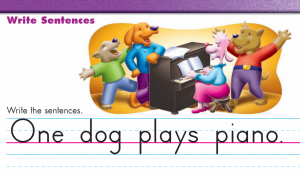Why Schools Should Keep Teaching Handwriting, Even If Typing Is More Useful

Screenshot / Zaner-Bloser Publishing
A sample from handwriting materials Columbus, Ohio, publishing company Zaner-Bloser makes for kindergarteners.
Even if computers will dot students’ I’s and cross their T’s for much of their life, Indiana University research suggests teaching them handwriting skills is still important in helping them learn to read.
That notion runs counter to current national standards. Indiana joined 43 other states last year in adopting a set of national curriculum guidelines that emphasize teaching students keyboarding skills. They hardly mention teaching handwriting, much less cursive writing, as Hoosiers have learned.
IU psychology professor Karin James says that might be unwise. She conducted the research that found teaching young children to write letters activated parts of their young brains that become critical for reading.
- Handwriting & The Young BrainSome researchers worry losing focus on handwriting in general—not just cursive—could have huge consequences for students’ growing brains.Download
“It might be fine [to give the option not to teach handwriting anymore], but we don’t know that,” James says. “And the research is pointing to that it might not be fine, you might be setting up a child’s brain to interpret letters and words in a very different way.”
James’ experiment involved a group of a dozen four- and five-year olds. She scanned their brains, then split them into two groups — one was shown letters and instructed to recognize them visually, the other was taught to write letters. This training went on over four weeks.
—Kathleen Wright, textbook publisher
When she put the kids back into the brain scanner, the two groups showed very different results: The scans for the group that was simply shown letters didn’t look that different. But in the scans for the group that learned to write the letters, James saw a huge spike in activity in their brains’ reading network.
“It’s not just that you’re using your hands to create the letters, because typing seems to be different than handwriting,” James says. “It’s that you’re actually creating those forms with your hands. That seems to be making a difference.”
Literacy expert and Vanderbilt University education professor Steve Graham says the implications for James’ work in an educational setting aren’t clear. Handwriting is clearly important in education, Graham says, but typing should also be taught in the classrom.
“I’m not sure what it means that more parts of the brain light up when you do handwriting versus when you find with any other activity,” Graham said. “It’s not necessarily surprising that particular parts of the brain light up when you do certain kinds of activities. With something like typing, that’s a simpler motor skill, so I’d expect less of the brain to light up.”
Read our full Q&A with Graham here.
Last April, the Indiana Department of Education gave school districts the option to stop teaching cursive in schools beyond third grade because of the state’s adoption of those national curriculum standards, known as the Common Core State Standards. The story made headlines across the country and even in some international newspapers.
But even though the Common Core emphasizes keyboarding, most agree it’s not likely that districts will stop teaching handwriting altogether.
Kathleen Wright, national product manager for Ohio-based Zaner-Bloser Publishing, says overall sales for her company’s handwriting texts haven’t seen a dip. But schools are buying fewer texts for older grades.
“[Schools] aren’t teaching it as far into the elementary years as they would before,” Wright says. “Whereas people might buy their program K-5 before, now they buy it K-3.
“It sounds old-fashioned when you put forth the argument that you lose connection with the past,” Wright says. “But then there’s also that scientific aspect of it. We don’t know what’s going to happen later on if you don’t teach children how to write on paper or how to write cursive.”
Podcast: Play in new window | Download


